Terms: REFLEXOLOGY MICROCOSM ZONES WEIGHT BEARING STRUCTURAL REFLEXOLOGY®…
The practice of reflexology has been misunderstood for years, and quite possibly for about 5000 years which takes us back to its origin. Every so often I hear people say reflexology is a form of meridian therapy or acupressure, and is a healing art that began in China. None of these notions are true. To the best of my knowledge the genesis of reflexology is attributed to a hieroglyph inscribed on the tomb of an Egyptian physician, dated 2330BC, depicting Egyptians performing a form of therapy on the bottom of the feet and hands. During this era many people from around the world flocked to Egypt which was the land for higher learning to bring knowledge back to their homeland. The chance for misinterpretation was likely since a language barrier between cultures left each to decipher what was taught through drawings and statues.
Here is a list of some terms associated with reflexology. I hope this helps to clarify questions you may have:
REFLEXOLOGY– A science and artful method of releasing stress in the body by working within microcosms of the body, such as the feet, hands, and ears. Most reflexologists use active methods of thumb and finger walking techniques to stimulate reflex sites that correspond with another part of the body. Below is my image of thumb walking the kidney reflex.
Below is my image of thumb walking the kidney reflex.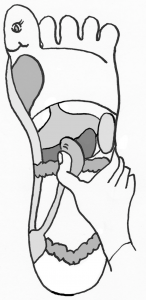
MICROCOSM– A miniature of the whole. In the reflexology world, the feet together are a microcosm of the entire body. The left foot represents the left side of the body, and the right foot represents the right side of the body. The spine of the body is represented by the arch of each foot and is the dividing line for the body.
This image is a drawing of my feet with the organ systems.
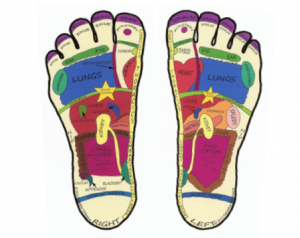
ZONES– Reflexologists thumb-walk up zones on the feet which are avenues to identify and relate areas of stress on the feet to the body above them. Horizontal guidelines divide each foot into regions allowing the practitioner to associate the feet in sections according to the organization of the body. For example, the diaphragm line defines the area under the balls of the feet with the chest region, the waistline helps one to know the general organ position of the transverse colon, the pelvic line is correlated with the line of the pelvic girdle. Below is my drawing of a person looking down at their feet. Viewer is looking at the zones separated by dotted lines on the bottom of the feet.
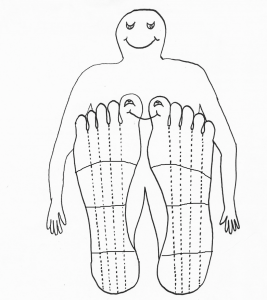
WEIGHT BEARING-In referring to the practice of Structural Reflexology, weight bearing is an important component of how well the body can rely on the foundation of the feet to stay upright and balanced. It also speaks to the efficiency of how well the body can move under all conditions we walk and play on. When the feet become weak, the body will eventually collapse into this weakness. When the feet maintain strength–the body responds in like.
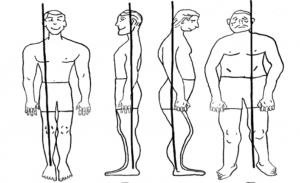
STRUCTURAL REFLEXOLOGY®-is the practice of integrating foot reflexology with anatomy, physiology, and kinesiology by using local and reflexive methods to release stress and compensation in the entire body. Structural Reflexology addresses tension sites on the feet as the product of local muscle and ligament strain while maintaining an understanding of how these sites of tension on the feet will impact the rest of the body.
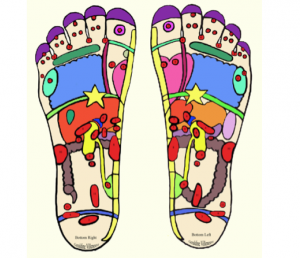
This is my Structural Reflexology map. The red areas indicate sites of where muscles from the lower leg attach to the foot. When tension brews in any one of these muscles it will change how the foot can move and eventually the reflexes beneath will reveal the areas in the body that become affected.
Archives
- October 2024
- December 2023
- October 2023
- March 2022
- July 2021
- August 2020
- May 2020
- April 2020
- February 2020
- January 2020
- December 2019
- November 2019
- October 2019
- August 2019
- June 2019
- May 2019
- April 2019
- January 2019
- December 2018
- October 2018
- September 2018
- July 2018
- June 2018
- April 2018
- February 2018
- December 2017
- November 2017
- October 2017
- September 2017
- August 2017
- July 2017
- June 2017
- May 2017
- April 2017
- February 2017


